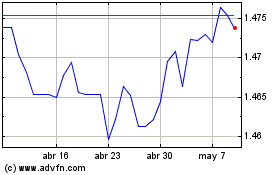Euro Falls As Weak Eurozone PMI Triggers ECB Rate Cut Bets
22 Noviembre 2024 - 1:37AM
RTTF2
The euro weakened against other major currencies in the European
session on Friday, as traders bet a possibility of an interest-rate
cut by the European Central Bank (ECB) after data from Germany and
the Eurozone showed that the business activity in the private
sector contracted in November.
Concerns about trade war with the United States (US) have
already caused most European Central Bank (ECB) officials to worry
about sluggish growth.
Data from S&P Global showed that the euro area private
sector fell back into contraction in November. The composite output
index registered 48.1 in November, which was a ten-month low, and
down from 50.0 in October. The renewed decline in output was
recorded as business activity in the service sector decreased for
the first time in ten months, joining manufacturing in contraction
territory.
Germany's private sector continued to contract in November as
sustained weakness in manufacturing output was compounded by the
first fall in services activity for nine months. The HCOB composite
output index dropped to 47.3 in November from 48.6 in the previous
month. The score signaled acceleration in the rate of decline in
activity to the quickest since February.
Services business activity fell into contraction for the first
time in nine months in November. The services PMI registered 49.4,
down from 51.6 in the previous month. The expected score was
51.8.
France's private sector contracted the most since January as
prolonged weakness in demand damped expectations. The flash HCOB
composite output index fell markedly to 44.8 in November from 48.1
in October.
The factory PMI posted 43.2, which was down from 44.5 in
October. The indicator was expected to edge up to 44.6
In economic news, data from Destatis showed that German economy
grew marginally in the third quarter after a contraction,
preventing a technical recession. Gross domestic product posted a
sequential growth of 0.1 percent in the third quarter. The rate was
downgraded from 0.2 percent estimated on October 30.
In the second quarter, GDP shrank 0.3 percent. Although the
economy avoided a technical recession with the third quarter
growth, the pace of expansion was only marginal.
Economic data updates from the region as well as the lingering
geopolitical concerns are however seen swaying market
sentiment.
In the European trading now, the euro fell to nearly a 10-year
low of 0.9206 against the Swiss franc, a 2-year low of 1.0333
against the U.S. dollar and nearly a 2-month low of 159.91 against
the yen, from early highs of 0.9295, 1.0499 and 159.91,
respectively. The euro is likely to find support around 0.90
against the franc, 1.02 against the greenback and 158.00 against
the yen.
The euro slipped to nearly a 2-week low of 0.8268 against the
pound, from an early 2-day high of 0.8347. On the downside, 0.81 is
seen as the next support level for the euro.
Against Australia, the New Zealand and the Canadian dollars, the
euro slid to nearly a 1-1/2-year low of 1.5968, nearly a 2-month
low of 1.7746 and more than a 9-month low of 1.4489 from early
highs of 1.6134, 1.7965 and 1.4657, respectively. If the euro
extends its downtrend, it is likely to find support around 1.58
against the aussie, 1.76 against the kiwi and 1.40 against the
loonie.
Looking ahead, Canada new housing price index for October,
retail sales for September, U.S. PMI data for November, U.S.
University of Michigan consumer sentiment for November and U.S.
Baker Hughes weekly oil rig count data are slated for release in
the New York session.
Euro vs CAD (FX:EURCAD)
Gráfica de Divisa
De Nov 2024 a Dic 2024

Euro vs CAD (FX:EURCAD)
Gráfica de Divisa
De Dic 2023 a Dic 2024
